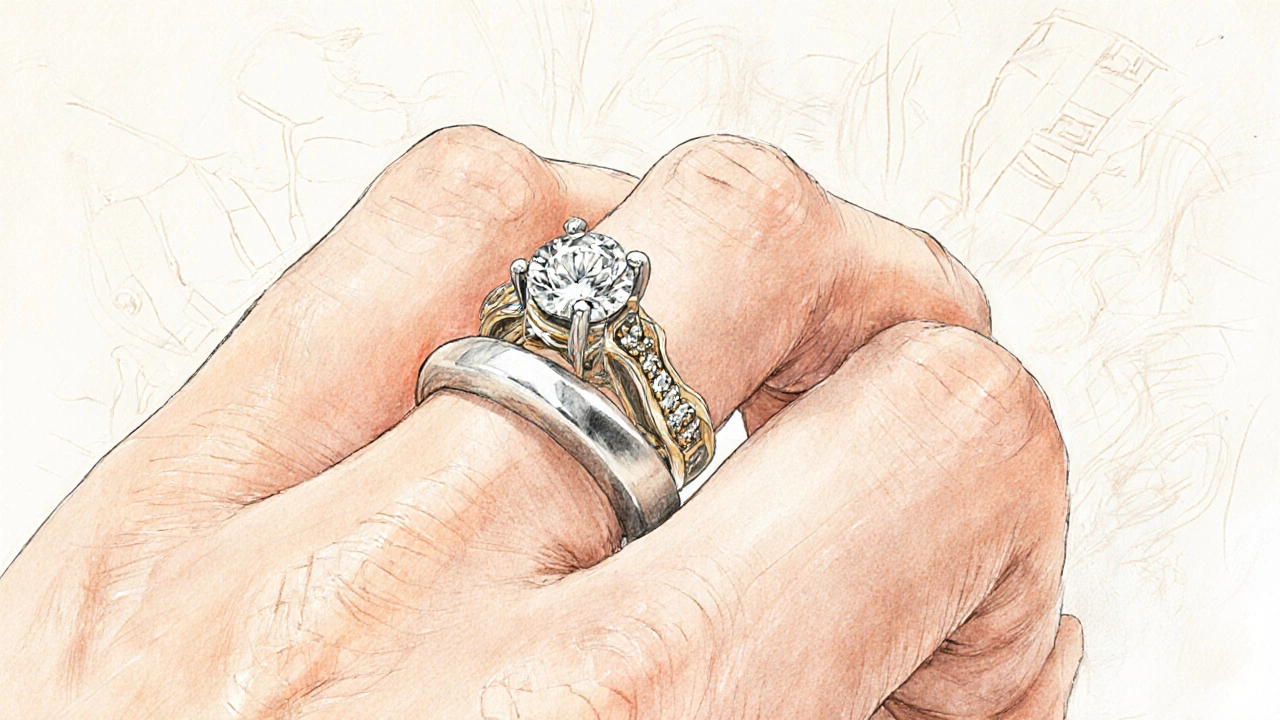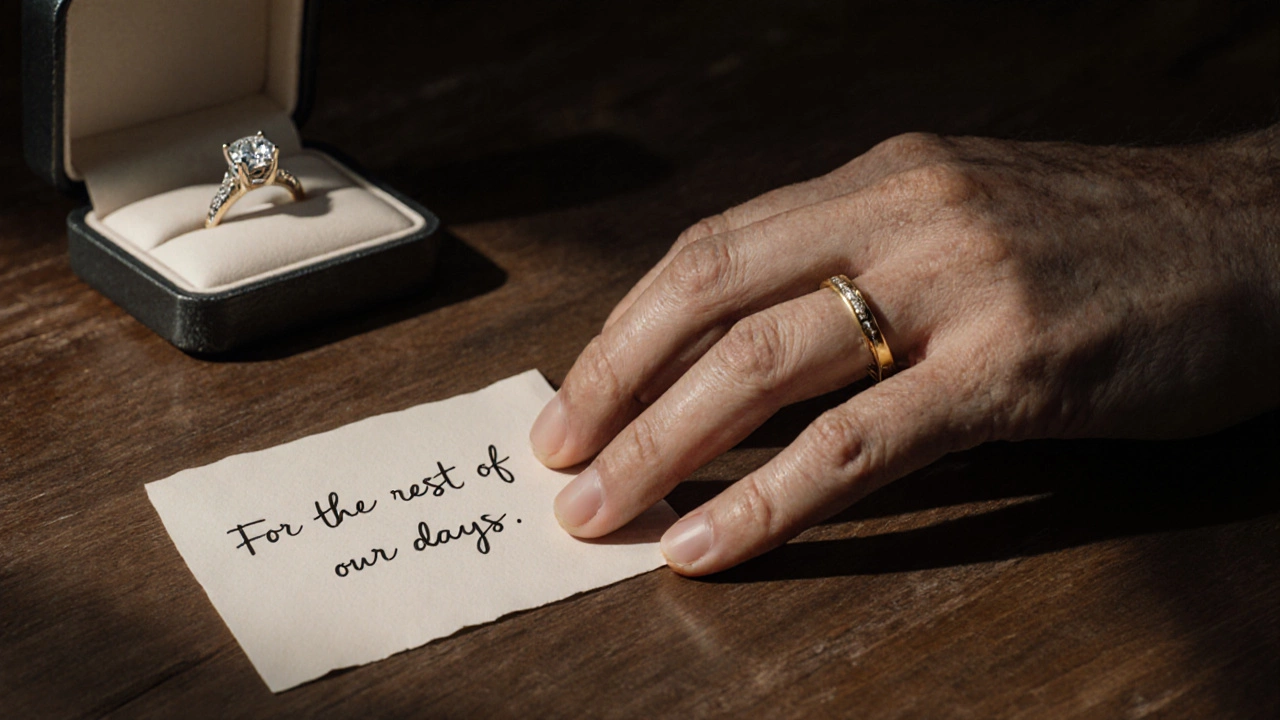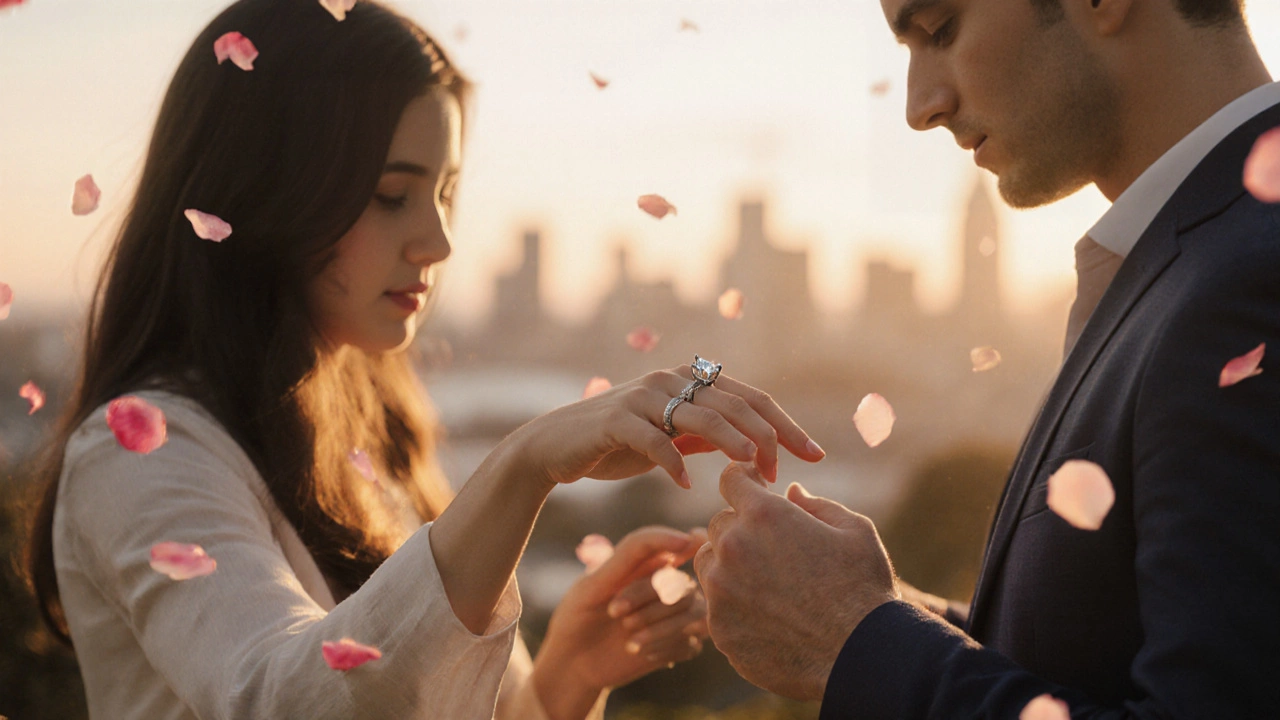Many people think a wedding ring and an engagement ring are the same thing. They’re both worn on the left hand, both are usually made of metal, and both are symbols of love. But they’re not the same. Knowing the difference isn’t just about tradition-it affects how you buy, wear, and even pair them together.
Engagement rings are about the proposal
An engagement ring is given when one partner proposes. It’s the physical sign that a marriage is planned. These rings are often more eye-catching. Think diamonds, intricate settings, or colored gemstones. In New Zealand, it’s common to see solitaire diamonds on white gold or platinum bands, but rose gold and emeralds are growing in popularity too.The engagement ring is meant to stand out. It’s the ring you show off when you say yes. It’s the one your friends ask about. It’s the one you wear every day leading up to the wedding. Some couples spend months choosing it. Others inherit one. But whatever the style, its job is simple: say, "I want to marry you."
Wedding rings are about the ceremony
A wedding ring-also called a wedding band-is exchanged during the ceremony itself. It’s usually simpler. Plain metal, no stones, or maybe a thin row of tiny diamonds. The focus here isn’t on sparkle. It’s on unity. The band represents the endless circle of commitment.In many cultures, including here in Auckland, the wedding band is worn closest to the heart-under the engagement ring. That’s why it’s often thinner. It needs to fit snugly next to the engagement ring without feeling bulky. Many couples choose matching bands, like two simple platinum rings, to wear together after the wedding.
They’re worn differently
On the day of the wedding, most people wear both rings. The engagement ring stays on the left ring finger. Then, during the ceremony, the wedding band is slipped on first, right next to the knuckle. After that, the engagement ring goes back on top. So the order is: wedding band underneath, engagement ring on top.Some people switch it up after the wedding. They move the engagement ring to the right hand and wear only the wedding band. Others stack them together. There’s no rule. It’s personal. But the key point? The wedding band is the one you wear every single day, rain or shine, for the rest of your life.
Cost and design are rarely the same
Engagement rings usually cost more. In New Zealand, the average engagement ring runs between $3,000 and $8,000, depending on the stone and metal. Wedding bands? They’re often under $1,000. A plain gold band might cost $400. A diamond eternity band might go up to $2,500-but that’s the exception.Design-wise, engagement rings are about individuality. You pick a style that reflects your partner’s taste. Maybe it’s vintage, maybe it’s modern. Wedding bands are about harmony. They’re chosen to complement the engagement ring, not compete with it. That’s why you’ll see so many couples choose matching metals and similar widths.

History tells the story
The tradition of the engagement ring goes back to ancient Rome, where iron rings symbolized ownership. Diamonds didn’t become popular until the 1940s, thanks to a famous De Beers ad campaign that linked diamonds to eternal love.The wedding band, though, is older. Ancient Egyptians believed the vein in the fourth finger of the left hand led straight to the heart. They called it the "vena amoris." That’s why rings went there. Romans later adopted the practice, but they used plain iron bands for marriage. The idea wasn’t to impress-it was to bind.
So the engagement ring is a modern symbol of romance. The wedding band is a centuries-old symbol of commitment. One is a promise. The other is a pledge.
What if you only want one ring?
More couples today are choosing to wear just one ring. Maybe they don’t like the cost. Maybe they find stacking uncomfortable. Maybe they just prefer minimalism. That’s completely fine.Some people wear the engagement ring as their only ring after the wedding. Others trade the engagement ring for a simple band that works for work, travel, and daily life. Some even get a custom ring that blends both-like a band with a subtle diamond accent on the side. These are called "unity rings" or "combination rings."
There’s no right or wrong. The only rule? It should feel true to you.
How to choose the right wedding band
If you’re planning to wear both rings, the wedding band needs to fit well with your engagement ring. Here’s what to look for:- Match the metal-if your engagement ring is yellow gold, go with yellow gold for the band. Mixing metals can look messy.
- Consider the profile-if your engagement ring has a low setting, a flat wedding band sits better. If it’s high-set, a curved band (called a "contour band") hugs the shape.
- Think about comfort-a band that’s too thick can dig into your finger. Most wedding bands are 1.5mm to 3mm wide. That’s the sweet spot.
- Try them together-always wear both rings side by side before buying. What looks good in a display case might feel awkward on your hand.
Many jewelers in Auckland offer free ring stacking sessions. Bring your engagement ring in, and they’ll show you 3-5 band options that fit perfectly. It’s a small step that saves a lot of regret later.

Common mistakes to avoid
People make a few predictable mistakes when choosing wedding rings:- Buying the wedding band before the engagement ring-you can’t pick a band that matches if you don’t know the shape or metal of the engagement ring yet.
- Choosing a thick band for a delicate engagement ring-it can make the engagement ring look small or lost.
- Ignoring durability-if you work with your hands, a plain band without stones lasts longer. Prongs on an engagement ring can catch on things. A smooth band won’t.
- Forgetting sizing-fingers swell in heat, after exercise, or during pregnancy. Get sized in the afternoon, and tell the jeweler if you’re planning to wear both rings together.
And don’t rush. This isn’t a last-minute decision. Take your time. Look at real people wearing the rings-not just photos. Visit three jewelers. Ask to try on different widths. Feel the weight. Wear them for a day. Your hands will tell you what’s right.
It’s not about the price-it’s about the meaning
There’s pressure to spend a lot. To follow trends. To impress. But the truth? The most meaningful rings are the ones you choose together, not because of a price tag or a brand.I’ve seen couples who bought a $200 silver band and a $500 engagement ring, and they wear them every day like they’re priceless. I’ve seen others with $20,000 rings who never wear them because they’re too bulky or too flashy for real life.
The ring that lasts isn’t the most expensive one. It’s the one you forget you’re wearing because it just fits-like a second skin.
Can you wear an engagement ring without a wedding band?
Yes, absolutely. Many people wear only their engagement ring after the wedding, especially if they work with their hands, prefer minimal jewelry, or find stacking uncomfortable. The engagement ring still symbolizes marriage-it just doesn’t have a matching band. Some couples even get the engagement ring resized or modified to feel more like a wedding ring.
Do you have to have a diamond engagement ring?
No. Diamonds are popular, but they’re not required. Sapphires, emeralds, moissanite, and even lab-grown stones are common choices in New Zealand. Many couples choose birthstones or family heirlooms. What matters is the meaning behind it, not the stone’s value or rarity.
Which ring goes on first during the ceremony?
Traditionally, the wedding band is placed on first, closest to the heart. Then the engagement ring is slid back on top. This order symbolizes that the commitment of marriage comes before the promise of engagement. But if you prefer to wear the engagement ring on top at all times, you can keep it there during the ceremony and just slide the band underneath after.
Can you wear a wedding ring on the right hand?
Yes. In some cultures, including parts of Europe and Eastern Europe, wedding rings are worn on the right hand. In New Zealand, it’s mostly left, but if you’re left-handed and find the ring gets damaged, or if you just prefer the right hand for personal reasons, there’s no rule against it. What matters is what feels right to you.
What if my engagement ring doesn’t match my wedding band?
That’s okay. Not every couple’s rings match perfectly-and that’s not a problem. Some people love the contrast. A vintage diamond engagement ring with a simple titanium band looks modern and bold. A rose gold ring with a white gold band creates a soft, layered look. If the fit is comfortable and the style feels like "you," it’s perfect. You can always get a custom band made later to bridge the gap.
Final thought: Your rings, your story
There’s no checklist for what your rings should look like. No official guidebook. No wedding police. The difference between a wedding ring and an engagement ring isn’t just in design or cost-it’s in the story they carry. One says, "I’m choosing you." The other says, "I’m staying with you."Wear them how you want. Stack them. Separate them. Mix metals. Skip one. Make your own tradition. The only thing that matters is that they feel like yours.

